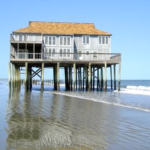Plum Island Point Erosion
February 21, 2016 by Chris Hein
Gloucester Point, VA 20 February 2016
There has been a lot of well-founded concern and quite a few news articles lately about the erosion on Plum Island Point (Reservation Terrace), the section of northeast Plum Island that resides northwest of the South Jetty and effectively within the mouth of the Merrimack River Inlet. See, for example here and here.
Theories as to why this is occurring generally point to the recent repair work on the south jetty and include the plugging of of a “river of sand” from the beach south of the jetty, up through the jetty and into the Point. Another idea proposed has been that repairing the jetty has allowed the jetty to do, well, what jetties do: narrow the river, constricting the flow of water that passes through during the flooding and ebbing tides, and forcing that water to move through faster (I think back to high school physics: a volume of water flowing from a wide pipe into a narrower pipe will have to speed up due to the pressure of the water moving in from behind it). The faster water moves, the more sediment it can carry, and the more erosion it can cause.
Both of these are entirely plausible theories. In fact, they both might play a role. Proponents of each point to times in the past when the jetty was repaired and there was erosion on The Point. I, personally, do not have the data to support or refute either. However, one of the key rules of science is that correlation does not mean causation. In other words, just because there appears to be a coincidence of timing between the jetty repair work and the erosion, does not mean that the former caused the latter. Of course, it also doesn’t mean that the jetty repairs didn’t cause the erosion . . .
There have been calls for a proper scientific study of this deeply disconcerting issue. As a scientist who has been studying Plum Island since 2007 (first the formation of the island over the past 6000 years, and in the last two years the erosion along Center Island through Fordham Way), I, of course, could not agree more. Science needs to play a central role in planning for the short-term (how to deal with the erosion issue occurring now to ensure no homes are threatened?), the medium-term (how to better engineer northern Plum Island to best ensure the viability of both The Point and the areas threatened in Newbury?), and the long-term (what are the local threats from climate change [for example, in terms of storms and sea-level rise] and how do we best plan for mitigation or, as recently proposed by local author Bill Sargent). I’ll stress that the decisions on solutions are political and social, not scientific, but they should use the best science available. Right now, that science is not available on the Plum Island Point erosion issue. Believe me, though, I know how the generally slow pace of science can feel when you house is threatened. My personal opinion (not necessarily that of this research team, VIMS, NSF, etc) is that there is a political need to seek a short-term solution to ensure against property damage from the current erosion, though that should be a temporary “soft” engineering solution.
So, all that said, there is another aspect of this that the science I and my team have been doing CAN address: that is the suggestion that has been made that the jetties (or at least the south jetty) be removed. Again, the decision to do so is societal, not scientific. However, as part of the Plum Island Research project, we do actually have some neat data to share that can tell us a lot about what may happen to northern Plum Island if the jetty (or jetties) were to be removed. I’ll be presenting it in a few weeks at an international meeting. Look for a new post tomorrow in which I’ll share details and a copy of the scientific poster!
— Chris


 Posted: February 18, 2017
Posted: February 18, 2017